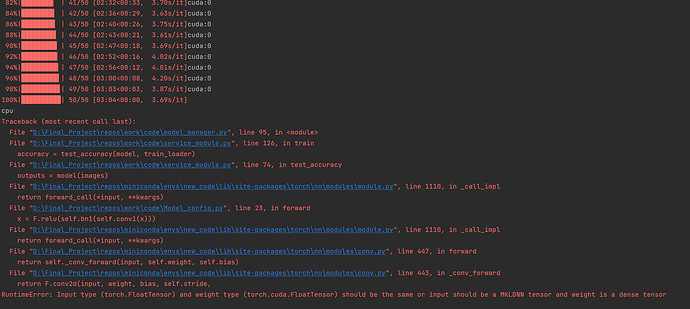Hi @ptrblck. Could you help me with these issue?
I’ve moved data, model and loss func to cuda, but it seems the input tensor is not switching to cuda
The model is a CNN with a embedded quantum circuit.
RuntimeError : Input type (torch.FloatTensor) and weight type (torch.cuda.FloatTensor) should be the same or input should be a MKLDNN tensor and weight is a dense tensor
train_data = torchvision.datasets.ImageFolder(path_to_train', transform=transforms.Compose([transforms.ToTensor()]))
test_data = torchvision.datasets.ImageFolder('path_to_test', transform=transforms.Compose([transforms.ToTensor()]))
train_loader = DataLoader(train_data, shuffle=True, batch_size=1)
test_loader = DataLoader(test_data, shuffle=True, batch_size=1)
for data, target in train_loader:
data = data.to(device)
target = target.to(device)
for data, target in test_loader:
data = data.to(device)
target = target.to(device)
class Net(Module):
def __init__(self, qnn):
super().__init__()
self.conv1 = Conv2d(3, 1, kernel_size=5)
self.conv2 = Conv2d(1, 1, kernel_size=5)
self.dropout = Dropout2d()
self.fc1 = Linear(3844, 64)
self.fc2 = Linear(64, 2) # 2-dimensional input to QNN
self.qnn = TorchConnector(qnn) # Apply torch connector, weights chosen
# uniformly at random from interval [-1,1].
self.fc3 = Linear(1, 1) # 1-dimensional output from QNN
def forward(self, x):
x = F.relu(self.conv1(x))
x = F.max_pool2d(x, 2)
x = F.relu(self.conv2(x))
x = F.max_pool2d(x, 2)
x = self.dropout(x)
x = x.view(x.shape[0], -1))
x = F.relu(self.fc1(x))
x = self.fc2(x)
x = self.qnn(x) # apply QNN
x = self.fc3(x)
return cat((x, 1 - x), -1)
model = Net(qnn)
model = model.to('cuda')
# Define model, optimizer, and loss function
optimizer = optim.Adam(model.parameters(), lr=0.001)
loss_func = NLLLoss().to('cuda')
# Start training
epochs = 10 # Set number of epochs
loss_list = [] # Store loss history
model.train() # Set model to training mode
for epoch in range(epochs):
total_loss = []
for batch_idx, (data, target) in enumerate(train_loader):
optimizer.zero_grad(set_to_none=True) # Initialize gradient
print(data.type, target.type)
output = model(data) # Forward pass
loss = loss_func(output, target) # Calculate loss
loss.backward() # Backward pass
optimizer.step() # Optimize weights
total_loss.append(loss.item()) # Store loss
loss_list.append(sum(total_loss) / len(total_loss))
print("Training [{:.0f}%]\tLoss: {:.4f}".format(100.0 * (epoch + 1) / epochs, loss_list[-1]))
